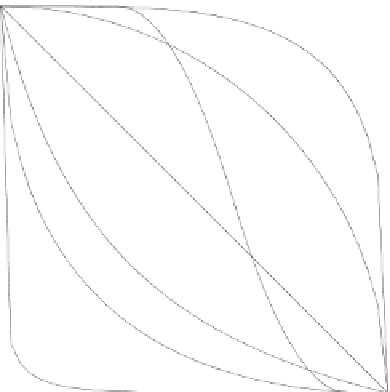Image Processing Reference
In-Depth Information
(1-x^4)^0.25
(1-x^2)^0.5
1-x
a = 0.3
b = 0.6
c = 0.9
n = 2
(1-x)/(1+3x)
(1-x^0.5)^2
(1-x^0.25)^4
Figure 8.2.
A few examples of fuzzy complementation
Additionally, we have:
t
(0
,
1) =
t
(0
,
0) =
t
(1
,
0) = 0,
t
(1
,
1) = 1 and 0 is a zero
element (
∀
x
∈
[0
,
1]
,t
(
x,
0) = 0).
Continuity is often added to this list of properties.
The operators min(
x, y
),
xy
, max(0
,x
+
y
−
1) are examples of t-norms, which
are by far the most commonly used.
T-norms generalize to fuzzy sets the concept of intersection as well as the logical
“and”.
The following result is easy to prove. For any t-norm
t
,wehave:
∀
[0
,
1]
2
,t
(
x, y
)
(
x, y
)
∈
≤
min(
x, y
)
.
[8.43]
This shows that the “min” is the highest t-norm and that any t-norm has a conjunc-
tive behavior.
On the other hand, any t-norm is always higher than
t
0
, which is the smallest t-
norm, defined by:
⎧
⎨
x
if
y
=1
[0
,
1]
2
,t
0
(
x, y
)=
∀
∈
(
x, y
)
y
if
x
=1
[8.44]
⎩
0
otherwise




















































Search WWH ::

Custom Search